Rigging an Asymmetric Spinnaker
Go To: Sailing - Techniques and Manoevres
Posted on 06 June 2009 19:17
Asymmetric spinnakers are easier in all aspects than symmetric spinnakers, including when rigging, due to the lack of a spinnaker pole.
Let’s assume you have all the necessary parts in front of you – a boat with bowsprit, spinnaker chute, spinnaker, spinnaker halyard, spinnaker sheet, and all the necessary blocks. Regardless of the type of boat you are rigging, it’s pretty similar for all.
First of all, lay out your sail. Unlike a symmetric spinnaker which has one head, and two clews, the asymmetric spinnaker is more like a big jib or genoa, with a head, tack and clew. The head is attached to the spinnaker halyard, the tack (front corner) to the end of the bowsprit, and the back corner to the spinnaker sheets.
If you’ve bought your boat second hand, then the pole retrieval lines should already be setup and ready – if they’re not, then you’ll have to refer to the manual or class association for the boat, as all boats are different. We’re going to assume your bowsprit is setup and ready, and you want to attach the spinnaker.
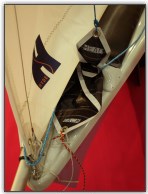
Photo 1, Different Chute Layouts
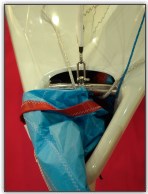
Photo 2, Different Chute Layouts
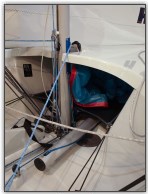
Photo 3, Different Cockpit Layouts
Take the top corner, and secure it to the spinnaker halyard, with a bowline (rather than a shackle). Next, hoist the sail, extend the bowsprit out, and attach the front corner, the tack, to the end of the bowsprit using whatever fixing is available.
Now you should have a giant sail flapping in the wind! Take hold of the clew (the back corner) and this is where you have options. You may have two spinnaker sheets, or just one long piece of rope as a continuous sheet. If it’s two separate ropes, then attach them both to this back corner. If it’s one, then you need to attach the one end to this corner, then take the other end all the way around, through the necessary blocks, back to the front around the other side and attach it there. We’re going to tell you which way to take it now...
Ensure your sail is set out correctly and not twisted at all. From the clew at the front, your spinnaker sheets should go one either side of the forestay, through a block that’s usually attached somewhere near the shroud, and into the boat. In the case of the continuous system, it goes across the boat, through the block the other side, and back around the front of the boat.
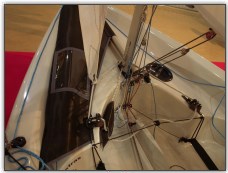
Photo 4, Different Cockpit Layouts
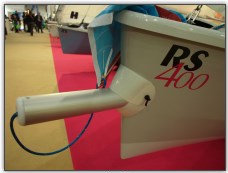
Photo 5, A bowsprit
So, now all your three corners are attached – there’s one thing left to do. Take the retrieval line (which is usually the other end of the halyard, and attach it to the retrieval patch on the spinnaker. This is where things get tricky – asymmetric boats have one particular side which is easier to drop on than the other, and this side will depend on the side your chute is on. As the sail has a particular shape, you cannot change this preferred side. You identify the preferred side, by looking at the sail when it is hoisted. Find out which side the retrieval patch appears on – if the sail is on the left hand or port side of the boat, with the retrieval patch pointing outwards, then the port side is the preferred hoist/drop side. You can hoist/drop it on the other side, but it will be more awkward to drop and can get trapped.
When you have found the preferred side, attach the retrieval line to the retrieval patch. If there are two retrieval patches, then simply pass the rope through the first one (do not tie it), and tie it on the second one. When you’re attaching the retrieval line, make sure the sail isn’t twisted into an hourglass.
When that’s done – you’re ready to test! It’s a good idea to test hoist and drop it a few times on land, where you can fix your mistakes if you’ve made any! Now, onto hoisting...